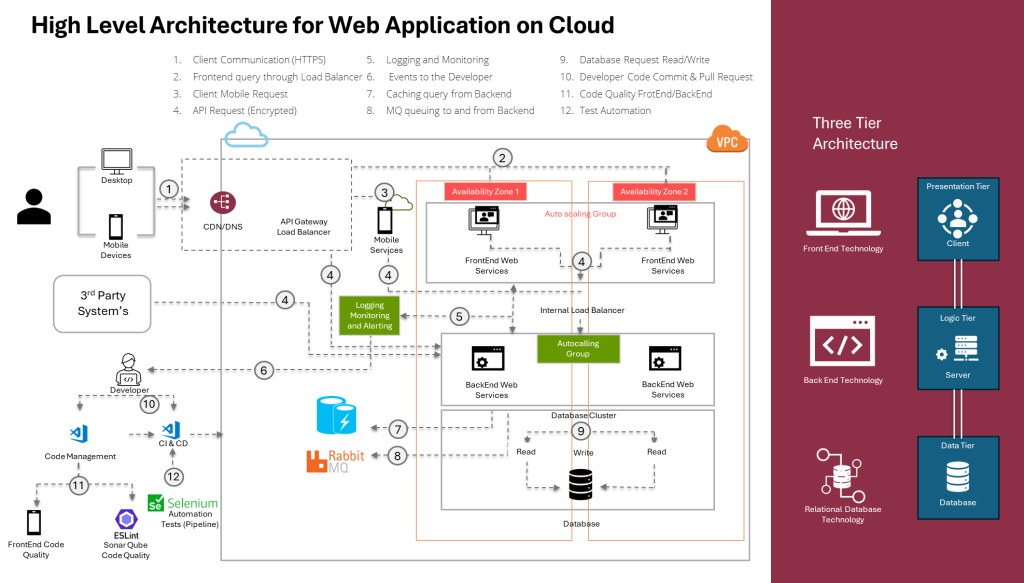In web development, the three-tier architecture model stands out as a robust and efficient approach to crafting scalable and manageable web applications. This architectural pattern segments the application into three distinct layers: the presentation tier, the logic tier, and the data tier. Each layer handles specific tasks, making maintenance, scalability, and flexibility easier.
Presentation Tier (Client): This is the frontend part of the application, interacting directly with users. It includes the user interface and client-side logic, typically implemented using technologies like HTML, CSS, and JavaScript. This layer displays data to the user and captures their inputs.
Logic Tier (Server): Also known as the application tier or business logic layer, this tier processes business logic and manages communication between the presentation and the data tiers. It includes core functionalities of the application, implemented with server-side technologies like Java, .NET, or Node.js.
Data Tier (Database): This tier manages data storage. It includes database servers and data storage solutions, typically employing relational databases like MySQL, PostgreSQL, or NoSQL databases like MongoDB. This layer ensures data integrity, security, and efficient data retrieval and storage.
Detailed Breakdown of the High-Level Architecture
Let’s dive into a high-level architecture for a web application deployed on the cloud.
Client Communication (HTTPS)
Users access the web application via desktop or mobile devices using HTTPS, ensuring secure communication.
FrontEnd Query through Load Balancer
Frontend queries are routed through a CDN/DNS and an API Gateway/Load Balancer for content optimization and traffic distribution, ensuring high availability and performance.
Client Mobile Request
Similar to desktop users, mobile users send requests to the application, which are processed through the load balancer.
API Request (Encrypted)
API requests from clients or third-party systems are encrypted for secure communication and routed to frontend web services.
Logging and Monitoring
A dedicated service captures logs and metrics for the application, providing insights and alerts for any issues or anomalies.
Developer Events
Developers receive event notifications and logs, enabling them to monitor the application’s performance and debug issues promptly.
Caching Query from Backend
Backend web services handle requests and use caching mechanisms to optimize response times for frequently accessed data.
MQ Queuing to and from Backend
Message queues like RabbitMQ facilitate asynchronous communication between different system parts, ensuring reliable and scalable task processing.
Database Request Read/Write
Backend services interact with the database cluster for reading and writing operations, ensuring data consistency and reliability.
Developer Code Commit & Pull Request
Developers commit code and create pull requests as part of the continuous integration and deployment (CI/CD) pipeline.
Code Quality FrontEnd/BackEnd
Tools like ESLint and SonarQube are used to maintain code quality for both frontend and backend components, enforcing coding standards and detecting issues early.
Test Automation
Automation tools like Selenium are integrated into the CI/CD pipeline to run automated tests, ensuring that new code changes do not introduce regressions and meet quality standards.
Wrapping Up
Implementing a three-tier architecture for web applications on the cloud offers numerous benefits, including scalability, manageability, and security. By separating the application into distinct layers and using cloud services for load balancing, caching, and monitoring, developers can build robust and efficient web applications that meet modern demands. The detailed architecture diagram shows how each component interacts, ensuring a seamless and high-performing web application.
This high-level architecture not only highlights the flow of data and requests but also emphasizes the importance of logging, monitoring, code quality, and test automation in delivering a reliable and maintainable web application. Following this architecture helps organizations handle growth and evolving user requirements.
Ready to transform your web applications with a robust three-tier architecture? Partner with Ropardo and leverage our expertise in scalable, manageable, and secure web development. Contact us today to learn how we can help you build the future of your business!

